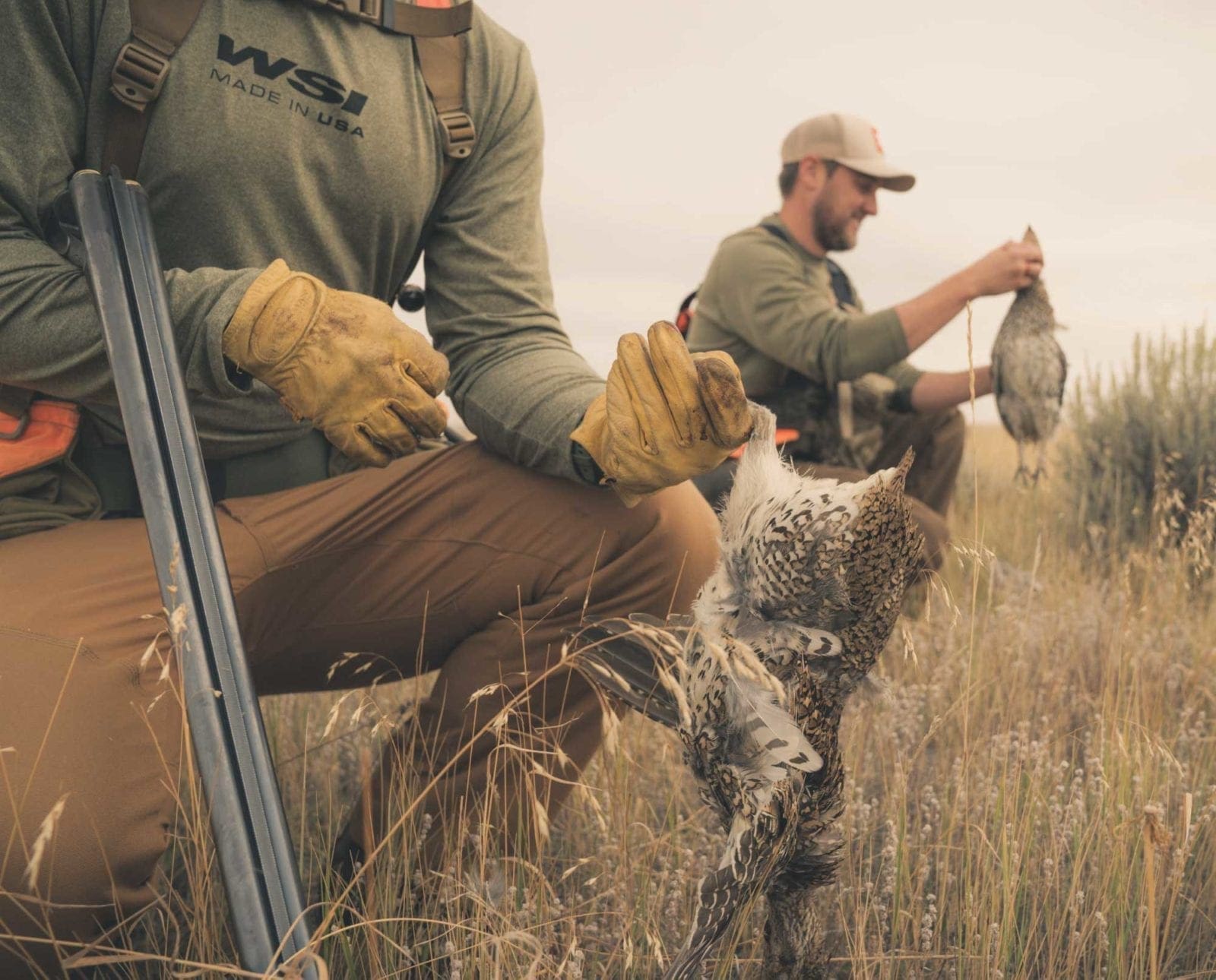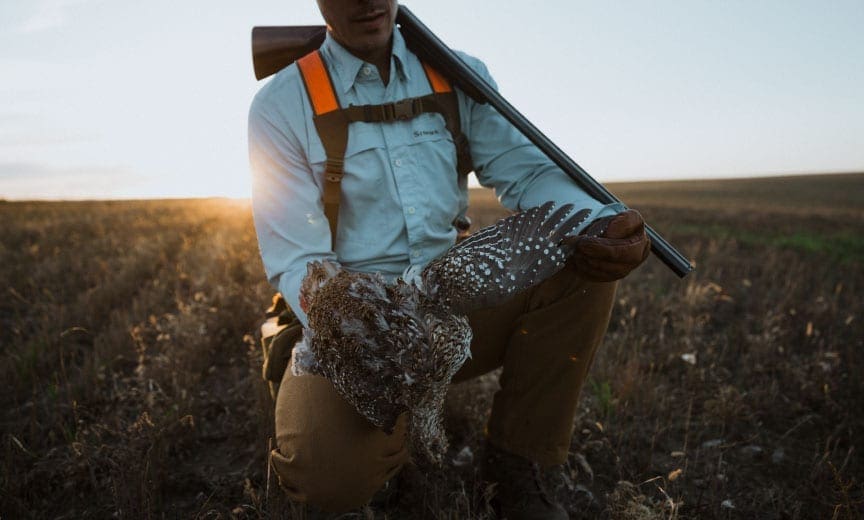Home » Grouse Species » Sharp-tailed Grouse Hunting » Choosing Shot Size and Chokes for Sharp-tailed Grouse Hunting
Choosing Shot Size and Chokes for Sharp-tailed Grouse Hunting

Rachelle Blair-Frasier is a Michigan native, bird dog enthusiast, and…
Exploring shot size and chokes sizes throughout the season for sharptail hunting
As a new hunting season approaches, we all begin the process of digging through our upland gear. We check over the vests and chaps for tears and holes from last season’s briars, and if you’re like me, find shotgun shells in various pockets or crevices of my hunting gear containers laying wherever it was that they last fell at the end of the previous season.
Listen to more articles on Apple | Google | Spotify | Audible
Looking these items over it brings to mind how we often tailor our gear to the game we intend to pursue. We were thinking of heading out west to chase sharp-tailed grouse but, never having hunted the species before, I wondered if there was a difference in shotgun gauge, shot size, or choke when out in the prairie chasing sharpies versus the ruffed grouse of the aspen forest. A chance encounter provided the opportunity to pick the brain of long-time sharp-tailed grouse hunter: Tyler Webster. The North Dakota native and host of the Birds, Booze, and Buds podcast has been chasing feathers since he was eight years old and has learned a lot during his time in the uplands.
“I started hunting out here and I never actually got to choose what shot I was going to use,” Webster said with a laugh. “I used whatever my grandpa chose for me.”
Back then what Grandpa chose was a single-shot 20-gauge with a fixed modified choke. In September they shot a lower-based shell and moved to higher power shells come October. Although technology as changed, the basics learned from his grandfather still hold truth in today’s hunting scenarios.
READ: Finding Sharp-Tailed Grouse Habitat
| Season | Chokes | Range* | Lead Shot Size | Steel Shot Size | Other Non-Toxic Shot Size |
| Early Season | Improved Cylinder | 10 – 25 Yards | No. 7 | No. 5 | No. 6 |
| Late Season | Modified | 20 – 35 Yards | No. 7 or 6 | No. 5 | No. 6 |
Is there a best shot size and choke for sharp-tailed grouse?
For early season sharp-tailed grouse, Webster recommends 7s if shooting regular lead and 5s if shooting regular steel with an improved cylinder. If you’re going with a premium steel shot or non-toxic shot such as bismuth, you can stick with the 7s or 6s.
“Early in the year the birds aren’t educated yet. They are young birds, the cover is a little bit thicker, and they are just going to hold tighter,” he says. “Sharptail grouse are not hard to knock down at all and they don’t really take a lot of punishment so 7 is a really nice round for them.”
As the season moves into October the birds start to get “wilder” and more feathered up as they prepare for winter.
“At that time I start upsizing my shot and tightening my chokes, so I go from 7s to 6s and with a modified choke,” Webster says. “That’s pretty much what I shoot for the rest of the year.”

Is there a best shotgun gauge for sharp-tailed grouse?
Webster prefers to use a 20- or 28-gauge when hunting sharptail grouse. His preference has more to do with weight than with effectiveness.
“You can kill sharptails with a 12-gauge, 16-gauge, or a .410,” he says. “In the end it all comes down to personal preference. The main thing is you’re going to be putting on a lot of miles when hunting sharptails so you need a gun that is going to be fairly light and easy to carry. Something that you can legitimately carry all day long. You may put in 12-14 miles a day out here walking the prairies and carrying a nine-pound 12-gauge kind of sucks.”
Is there a best kind of shot for sharp-tailed grouse?
Take a walk down the shotgun shell aisle of any outfitter and you could be shocked by the sheer variety of shotgun shells available for the upland hunter.
“When I was growing up, there weren’t terribly good shells out there. That’s going to be the biggest thing that has changed in upland hunting in the last twenty years: the quality of the new shells that are out there,” Webster says. “It doesn’t really matter what company you go with. They’re making some rounds now that we couldn’t even have dreamed of twenty years ago, as effectiveness goes. That has really been a game-changer.”
But is there one that out performs the rest when it comes to sharp-tailed grouse hunting? Webster says going with a premium shell seems to make a difference in his experience.
“I would rather shoot a really good premium shell that I could have a lot of confidence in rather than something that is just a little cheaper and doesn’t perform as well,” he says.
“If you shoot a little more expensive shell you’re going to have a lot more dead birds on the ground compared to wounded birds. But you don’t have to go crazy, a really good copper plated lead like a Federal that costs around $12-13 a box is not super pricey,” he says. “The number of birds you’re going to find dead where they fall is going to be massively higher than the standard lead. Anything copper plated is definitely worth the money. The penetration is better; it seems to hit harder.”
Bismuth, copper-plated bismuth, tungsten, and other non-toxic shot are also a great option for shooting at sharptails. They are similar to lead in that they maintain velocity downrange a little bit more, which is why it’s more effective than straight steel shot. Plus, as the name implies, it is non-toxic which is good news for the environment, the birds, and us.
Rachelle Blair-Frasier is a Michigan native, bird dog enthusiast, and former Managing Editor of Project Upland Magazine.




With pointing dogs # 8.5 skeet and lite mod chokes. 28 ga!